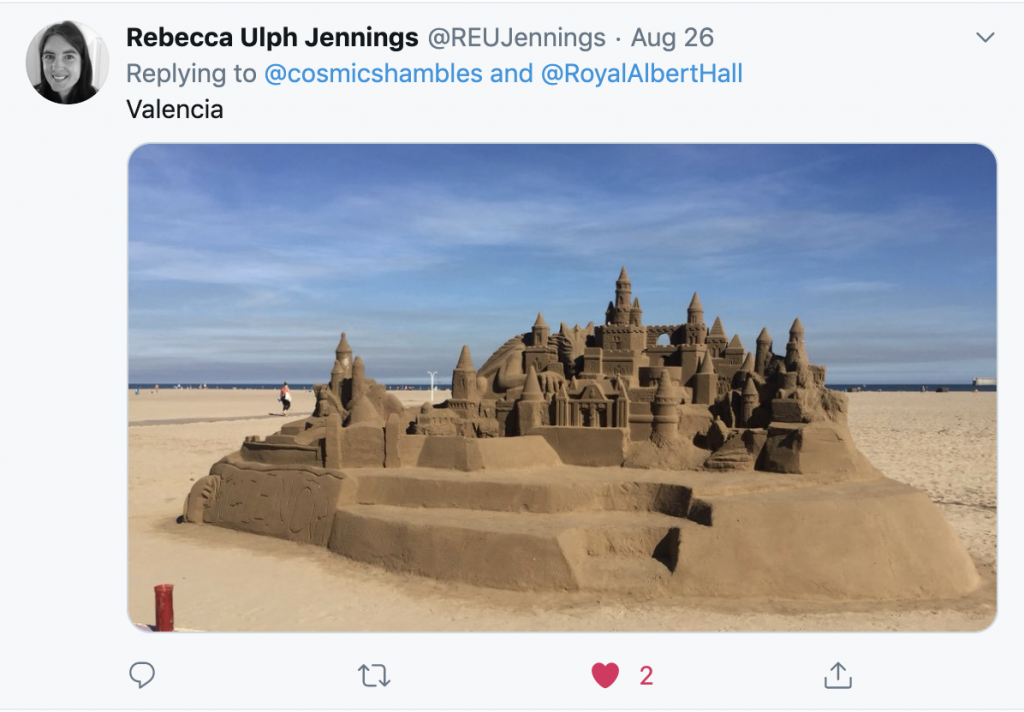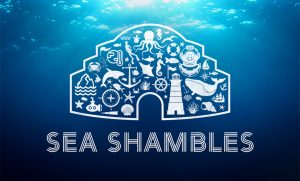A Tale of Two Sand Castles by Dr Helen Czerski
Sea Shambles Advent Calendar Day 14December 14th
Today’s blog is a tale of two sandcastles.

The first picture is from my co-host on an upcoming BBC4 programme about the oceans, George McGavin (@georgecmcgavin). When I told him about this project on our way home from a recent filming day, George diligently went through his phone for ocean-related pictures, and I’m really grateful to him for that. That gratitude may not be readily apparent, because I’m contrasting his friendly but humble sandcastle with this astonishing sand-citadel in Valencia, sent in by @REUJennings . However, there’s a really interesting tale here, and we need both photos to tell it.

Sandcastles are great fun, and part of that fun is their unpredictability. They permanently teeter on the edge of disaster, and just one lick of an encroaching wave or one misplaced pebble can cause a sand-slide, shearing off half the castle. We can’t actually see what holds them together, and so every sandcastle is a lottery ticket that depends on the beach and the conditions. But there’s no doubt that some beaches are better for sandcastles than others, and the trick is in physics that’s just a bit too small to see properly.
The first thing is that dry sand is useless for building anything. Dry sand grains can only push each other apart, so they can roll over the pile and sit on top of each other and that’s about it. Things only get interesting when you add water. But you can also have too much of a good thing – think about the really wet sand down by the ocean’s edge. That’s also useless for building, because it behaves like sludge. No-one wants to build a sandcastle out of something with the texture of blancmange. (Incidentally, whatever happened to blancmange? I haven’t seen any for years. Is it all hiding somewhere?).
The Cosmic Shambles Network relies on your support on pledges via Patreon so we can continue to provide great, new, exciting content without the need for third party ads or paywalls.
For as little as $1 a month you can support what we do and get some great rewards for doing so as well. Click the Patreon logo to pledge or find out more.
Things work far better when the sand grains are a little bit wet, which means that they’re connected by tiny bridges of water. Water is pretty sticky stuff, and if you put a droplet between two sand grains, it will stick to both, and move so it covers as much of the surface of both as possible. In practice, this means that the water forms a tiny ring around the points where grains touch, and because it’s so sticky, it acts like glue. The water surface will change shape to minimise the surface area of the ring, and this pulls the grains together. This is what holds sandcastles up, and this is why you can make a sandcastle with sharp edges. On a tiny scale, the water is acting like cement. But if you add too much water, it starts to act like lubricant instead of glue, helping the grains to slide over each other. At that point, all your sandcastle is going to do is slump sadly until it’s reclaimed by the beach.
There are two other major factors that matter. The first is the size of the grains. Surface tension is a small force, and so it can only really glue very small grains together. If the sand grains are too big (like the ones in George’s photo), the water-glue just isn’t strong enough to hold them together. Strong sandcastles are made from small grains.
The other thing is the shape of the sand. If the sand particles are super-smooth and polished, they’ll slide over each other easily, even if the water is sticking the contact points together. But angular sand grains with sharp edges interlock, giving your castle extra stability.
So the lesson of these two pictures is that they say more about the beaches than the builders. I’d bet that Valencia has nice angular sand with small grains, and that there was just enough water soaked into the beach to provide the perfect amount of glue. George never really stood a chance.
It’s the middle of winter, but if you do fancy going out to your local beach and making a Sea Shambles sandcastle (or any wintery sandcastle, really), do tweet a picture to us. We’ll be very impressed!
See what lies behind all the windows of the Sea Shambles Advent here.
This picture was from Dr Helen Czerski, posted on Twitter back when we first asked people for the sea pictures.
 Sea Shambles is a one night only live extravaganza celebrating the oceans. Hosted by Robin Ince and Helen Czerski with Steve Backshall, British Sea Power, Josie Long, Lemn Sissay and more it’s a night of science, comedy, music, lasers and more in which we’ll be turning the Royal Albert Hall into an underwater playground the likes of which you’ve never seen! May 17 2020. Tickets start at just £10! Book here.
Sea Shambles is a one night only live extravaganza celebrating the oceans. Hosted by Robin Ince and Helen Czerski with Steve Backshall, British Sea Power, Josie Long, Lemn Sissay and more it’s a night of science, comedy, music, lasers and more in which we’ll be turning the Royal Albert Hall into an underwater playground the likes of which you’ve never seen! May 17 2020. Tickets start at just £10! Book here.
 Dr Helen Czerski is a physicist, first and foremost, but she’s acquired a few other labels along the way: oceanographer, presenter, author and bubble enthusiast. A regular on The Cosmic Shambles Network, she has also presented a number of acclaimed documentaries for the BBC and Fully Charged. Recently she was awarded the prestigious William Thomson, Lord Kelvin Medal and Prize from the Institute of Physics.
Dr Helen Czerski is a physicist, first and foremost, but she’s acquired a few other labels along the way: oceanographer, presenter, author and bubble enthusiast. A regular on The Cosmic Shambles Network, she has also presented a number of acclaimed documentaries for the BBC and Fully Charged. Recently she was awarded the prestigious William Thomson, Lord Kelvin Medal and Prize from the Institute of Physics.
If you would like to reuse this content please contact us for details
Subscribe to The Cosmic Shambles Network Mailing list here.
The Cosmic Shambles Network relies on your support on pledges via Patreon so we can continue to provide great, new, exciting content without the need for third party ads or paywalls.
For as little as $1 a month you can support what we do and get some great rewards for doing so as well. Click the Patreon logo to pledge or find out more.

